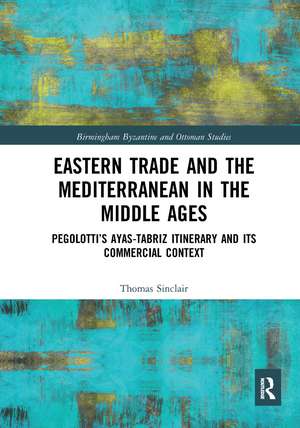Eastern Trade and the Mediterranean in the Middle Ages: Pegolotti’s Ayas-Tabriz Itinerary and its Commercial Context: Birmingham Byzantine and Ottoman Studies
Autor Thomas Sinclairen Limba Engleză Paperback – 30 iun 2021
To demonstrate the importance of the route in its own time, parallel and contemporary routes in the Black Sea and the Levant are traced and the effect of trade on their cities noted. To compare the Ayas itinerary (1250s to 1330s) with previous periods the networks of commercial avenues in the previous period (1100-1250) and the subsequent one (1340s to 1500) are reconstructed. In each period the connection of east-west trade with the main movements of the European economy are fully drawn out, and the effects on the building history of the three main Italian cities concerned (Venice, Genoa and Florence) are sketched.
Attention then turns to the Pegolotti itinerary itself. The individual toll stations are identified employing a variety of means, such as names taken from the Roman itineraries (Peutinger Table and Antonine Itinerary) and archaeological data; this allows the course of the track to be followed through diverse topography to the city of Sivas, then across plains and through passes to Erzurum and finally to Tabriz. A picture is drawn of the urban history of each major city, including Sivas, Erzurum and Tabriz itself, and of the other towns along the route.
| Toate formatele și edițiile | Preț | Express |
|---|---|---|
| Paperback (1) | 405.83 lei 6-8 săpt. | |
| Taylor & Francis – 30 iun 2021 | 405.83 lei 6-8 săpt. | |
| Hardback (1) | 876.36 lei 6-8 săpt. | |
| Taylor & Francis – 4 dec 2019 | 876.36 lei 6-8 săpt. |
Din seria Birmingham Byzantine and Ottoman Studies
-
 Preț: 388.46 lei
Preț: 388.46 lei -
 Preț: 310.65 lei
Preț: 310.65 lei - 15%
 Preț: 266.13 lei
Preț: 266.13 lei -
 Preț: 381.98 lei
Preț: 381.98 lei -
 Preț: 397.38 lei
Preț: 397.38 lei - 21%
 Preț: 258.06 lei
Preț: 258.06 lei -
 Preț: 399.29 lei
Preț: 399.29 lei - 18%
 Preț: 1009.91 lei
Preț: 1009.91 lei - 15%
 Preț: 242.74 lei
Preț: 242.74 lei -
 Preț: 373.43 lei
Preț: 373.43 lei - 18%
 Preț: 1003.43 lei
Preț: 1003.43 lei - 22%
 Preț: 328.20 lei
Preț: 328.20 lei -
 Preț: 389.38 lei
Preț: 389.38 lei - 25%
 Preț: 324.16 lei
Preț: 324.16 lei -
 Preț: 404.47 lei
Preț: 404.47 lei - 17%
 Preț: 256.87 lei
Preț: 256.87 lei - 25%
 Preț: 324.16 lei
Preț: 324.16 lei -
 Preț: 389.38 lei
Preț: 389.38 lei - 25%
 Preț: 776.84 lei
Preț: 776.84 lei - 25%
 Preț: 834.82 lei
Preț: 834.82 lei - 24%
 Preț: 766.00 lei
Preț: 766.00 lei -
 Preț: 387.91 lei
Preț: 387.91 lei -
 Preț: 311.41 lei
Preț: 311.41 lei -
 Preț: 469.34 lei
Preț: 469.34 lei -
 Preț: 388.72 lei
Preț: 388.72 lei - 30%
 Preț: 771.95 lei
Preț: 771.95 lei - 18%
 Preț: 1062.31 lei
Preț: 1062.31 lei - 18%
 Preț: 1008.53 lei
Preț: 1008.53 lei - 30%
 Preț: 873.95 lei
Preț: 873.95 lei -
 Preț: 489.26 lei
Preț: 489.26 lei
Preț: 405.83 lei
Nou
Puncte Express: 609
Preț estimativ în valută:
77.65€ • 81.08$ • 64.27£
77.65€ • 81.08$ • 64.27£
Carte tipărită la comandă
Livrare economică 05-19 aprilie
Preluare comenzi: 021 569.72.76
Specificații
ISBN-13: 9781032083407
ISBN-10: 1032083409
Pagini: 452
Dimensiuni: 174 x 246 x 23 mm
Greutate: 0.83 kg
Ediția:1
Editura: Taylor & Francis
Colecția Routledge
Seria Birmingham Byzantine and Ottoman Studies
Locul publicării:Oxford, United Kingdom
ISBN-10: 1032083409
Pagini: 452
Dimensiuni: 174 x 246 x 23 mm
Greutate: 0.83 kg
Ediția:1
Editura: Taylor & Francis
Colecția Routledge
Seria Birmingham Byzantine and Ottoman Studies
Locul publicării:Oxford, United Kingdom
Public țintă
PostgraduateCuprins
List of figures and maps
Transliteration, symbols etc.,
Author’s preface
PART A. INTRODUCTORY
PART B. THE AYAS-TABRIZ ITINERARY
PART C. CONCLUSIONS
Appendix I. Ottoman Routes of the 16th to 18th Centuries in the Sivas-Erzurum Sector
Appendix II. Coins
Bibliography
Index
Transliteration, symbols etc.,
Author’s preface
PART A. INTRODUCTORY
- The Documents and the Routes
- The Commercial Background
PART B. THE AYAS-TABRIZ ITINERARY
- Ayas to Sivas
- From Sivaz to Erzincan
- From Erzincan to Erzurum
- From Erzurum to Tabriz
PART C. CONCLUSIONS
Appendix I. Ottoman Routes of the 16th to 18th Centuries in the Sivas-Erzurum Sector
Appendix II. Coins
Bibliography
Index
Notă biografică
Thomas Sinclair was a professor of Turkish History at the Department of Turkish and Middle Eastern Studies in the University of Cyprus. He is the author of Eastern Turkey: An Architectural and Archaeological Survey (4 volumes, 1987-90) and writes principally on economy and administration in Armenia during the late pre-Ottoman and early Ottoman periods.
Descriere
At the end of the High Middle Ages in Europe, with buying power and economic sophistication at a high, an itinerary detailing toll stations along a commercial artery carrying eastern goods was compiled. A picture is drawn of the urban history of each major city, including Sivas, Erzurum and Tabriz itself, and of other towns along the route.
